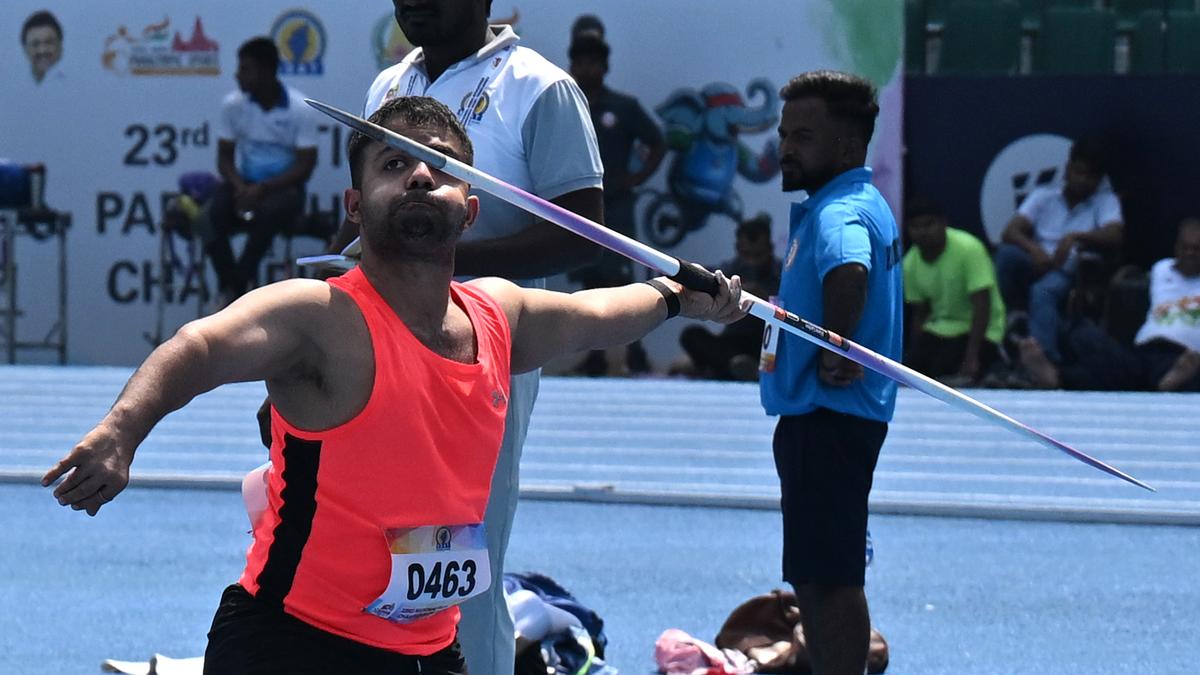The grit, grind, and the gold: The Navdeep Singh story
New Delhi’s Jawaharlal Nehru (JLN) Stadium is roughly three kilometres from Jangpura, a neighbourhood in South Delhi. A 17-year-old Navdeep Singh, taking his formative steps in javelin throw at the JLN, made the round trip on foot.
“ Jo cheez bina paison ke ho sakti thi, vo humne bina paison ke ki hai (Whatever could be done to save money, I did). I used to stay in a paying guest accommodation near Kotla. I then moved to Jangpura and trained at the JLN Stadium. I never travelled by the [Delhi] Metro. It took me around 30 minutes to walk. It saved money, which I could then spend on my diet,” Navdeep tells Sportstar on the sidelines of the Aces Awards in Mumbai.
Navdeep’s interest in javelin developed later than it does for most athletes. Like nearly every child in Haryana, wrestling was his first love. Despite being aware of his condition — Dwarfism, caused by a genetic mutation affecting bone growth — his father, himself a wrestler, encouraged him to pursue the sport.
“My father was a sportsperson too. A big positive was that I received a lot of support from him. I took up wrestling for about three to four years. I even won a bronze medal at a State championship. Sports have been part of my life since childhood, and they are mostly individual sports. I also took part in sprints for a while,” Navdeep says. He only discovered javelin throw after stumbling upon a Neeraj Chopra video on YouTube. Neeraj’s gold medal at the 2016 Under-20 World Championships piqued his interest, prompting him to move to New Delhi.
“I was 17 when I left Panipat. I initially stayed in Sonepat with my aunt and commuted daily from her house. Eventually, my father moved me to Delhi, so it was a gradual process. I did not have to convince them to let me go,” Navdeep says.
Surviving on a shoestring budget marked his early days in the capital. Often, he could not afford the nutrition required to sustain an athlete’s regimen. Dal and tandoori roti became his staples. Looking back, he believes that the period of struggle was instrumental in shaping his character.
“The struggle was necessary for me. It moulded me into who I am and gave me the ability to face any challenge. During that time, I realised, ‘ Navdeep, tu kya hai, tu kya kar sakta hai’ (Navdeep, what are you? What can you do?). That phase was important, and I will always be grateful for it,” Navdeep says.
Navdeep Singh celebrates with his gold medal in the men’s javelin throw F41 event at the 2024 Paris Paralympics.
| Photo Credit:
REUTERS
Navdeep Singh celebrates with his gold medal in the men’s javelin throw F41 event at the 2024 Paris Paralympics.
| Photo Credit:
REUTERS
His first breakthrough came in 2017 when he won gold at the Asian Youth Para Games in Dubai. However, life truly changed for him after his gold medal at the World Junior Para Athletics Championships in Switzerland in 2019. He was then inducted into the Khelo India programme before securing Target Olympic Podium Scheme funding to prepare for the Tokyo Paralympics in 2021.
Being included in the country’s top sports programme ensured a fixed monthly stipend and allowed him to train at the Sports Authority of India’s centre in Bengaluru.
“If I compare then to now, things have improved drastically. For my achievement at the Junior Worlds, I received support from the government. Now, athletes get similar support much earlier — after a Khelo India Games medal or a win at the Nationals. Previously, we had to secure international medals to receive the same backing. That is a positive change,” Navdeep says.
Tokyo setback to Paris triumph
Navdeep scrolls through his phone’s gallery, searching for a video of his meeting with Prime Minister Narendra Modi following his return from the Tokyo Paralympics in 2021. He had missed out on a bronze medal by just 60 centimetres, finishing fourth with a best throw of 40.80 metres.
Unable to find the video, he turns to his old ally — YouTube. He skips to the part where he promised the Prime Minister that he would win a medal at the next Paralympics.
Three years later, in Paris, Navdeep kept his word. With a best throw of 47.32 metres, he not only secured the gold medal but also shattered the Paralympic record in the F41 category.
“I think the first feeling was that I had removed the ‘loser’ tag that people had put on me after I finished fourth in Tokyo. I was satisfied that I had proven myself and that I was not a ‘loser’ just because someone else said so. That emotion came out in front of the camera and went viral,” Navdeep recalls.
Having faced societal rejection due to his genetic condition, Navdeep relied on introspection to carve a successful path in sport. It helped him navigate the Tokyo setback and played a pivotal role in his comeback.
Paris Paralympic gold medallist Navdeep Singh was honoured with a special award at the Sportstar Aces Awards in Mumbai on February 14, 2025.
| Photo Credit:
RITU RAJ KONWAR
Paris Paralympic gold medallist Navdeep Singh was honoured with a special award at the Sportstar Aces Awards in Mumbai on February 14, 2025.
| Photo Credit:
RITU RAJ KONWAR
“ Bohot zyada farak padta hai (What people say affects you). Even if someone makes a small comment about you, you start thinking about it. You wonder, ‘Why is that person saying this?’ If it happens repeatedly, you begin to doubt yourself — ‘Am I really like this?’ “If people say you’re not good, you start searching for faults within yourself. I have been through that phase. But then I worked on myself — how I could improve, understanding my strengths and weaknesses. I cut out all distractions, and the path became clear,” Navdeep says.
Although he blushes at being called a celebrity, fame has followed him post his triumph in Paris. He is an Arjuna awardee, frequently recognised in public, and often gets selfie requests. More importantly, he has nothing to prove anymore.
“A person should never be stagnant. I just want to keep improving. When you aim to keep getting better, you always set new targets to achieve, and that is what I want to keep doing,” Navdeep says.



